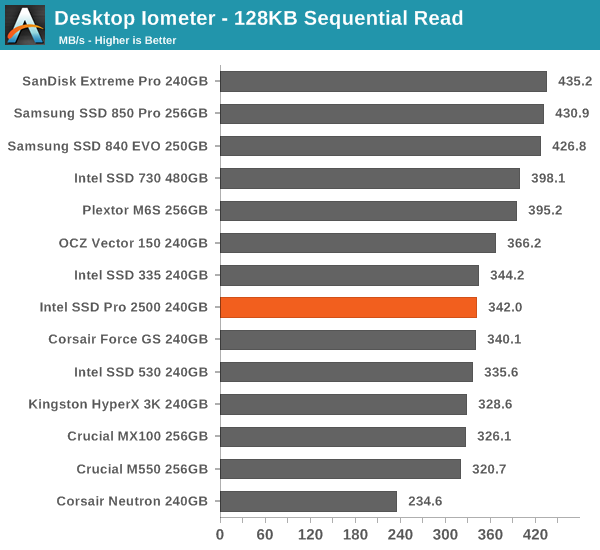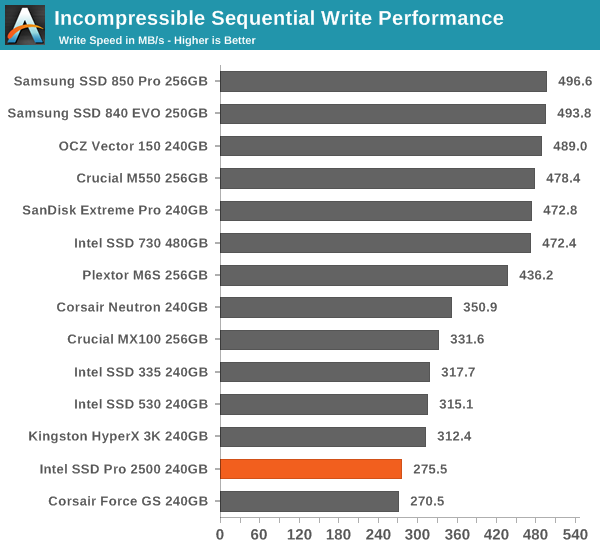Intel SSD Pro 2500 (240GB) Review
by Kristian Vättö on July 30, 2014 5:00 AM ESTRandom Read/Write Speed
The four corners of SSD performance are as follows: random read, random write, sequential read and sequential write speed. Random accesses are generally small in size, while sequential accesses tend to be larger and thus we have the four Iometer tests we use in all of our reviews.
Our first test writes 4KB in a completely random pattern over an 8GB space of the drive to simulate the sort of random access that you'd see on an OS drive (even this is more stressful than a normal desktop user would see). We perform three concurrent IOs and run the test for 3 minutes. The results reported are in average MB/s over the entire time.



Random performance is quite typical (and unsurprising) for SandForce. Once again the performance drops when switching to incompressible data, although at low queue depths the write performance is still relatively good despite the drop.
Sequential Read/Write Speed
To measure sequential performance we run a 1 minute long 128KB sequential test over the entire span of the drive at a queue depth of 1. The results reported are in average MB/s over the entire test length.

No surprises in sequential peformance either.

AS-SSD Incompressible Sequential Read/Write Performance
The AS-SSD sequential benchmark uses incompressible data for all of its transfers. The result is a pretty big reduction in sequential write speed on SandForce based controllers.












42 Comments
View All Comments
mmrezaie - Wednesday, July 30, 2014 - link
good for samsung.CrystalBay - Wednesday, July 30, 2014 - link
Good article as always Hellhound, Yes 850 P is wanted .AnnonymousCoward - Thursday, July 31, 2014 - link
As always, not a single real world test to tell us the tangible difference of this drive versus others.hojnikb - Wednesday, July 30, 2014 - link
Intel really dropped the ball on whole consumer ssd business.And now this drive. This thing doesn't even have a single intel component inside. So pretty much, this is a Sandforce drive with Intel badge on it.
Krysto - Wednesday, July 30, 2014 - link
Intel has dropped the ball on all consumer markets lately. They're losing billions a year subsidizing Atom, just to be price-competitive with ARM chips, and now they're a full year behind with Broadwell, which won't see mainstream shipping until first half of 2015. Also, Broadwell sucks, too. But that won't stop Intel from making bombastic claims about it, which I can already see ("HALF the power consumption of Haswell" - but with much lower performance, which we won't tell you about, until you've already been suckered into buying one).tarqsharq - Wednesday, July 30, 2014 - link
I remember when they slipped up with the P4 "NetBurst" architecture. Trying to win the Ghz wars.Maybe AMD will have a chance to come back on the chip end, I like their low end solutions that are coming out, and I miss being able to be an AMD fan boy and not be ignoring reality.
hojnikb - Wednesday, July 30, 2014 - link
> They're losing billions a year subsidizing Atom, just to be price-competitive with ARM chips, and now they're a full year behind with Broadwell, which won't see mainstream shipping until first half of 2015.Heh, i was not aware of that. It seems, that Intel needs to put its priorities right. :)
nonoverclock - Wednesday, July 30, 2014 - link
Wow. Exaggerate much and have an axe to grind? "Losing billions a year"? "Broadwell sucks, too" - I haven't read that review yet can you link to it?extide - Wednesday, July 30, 2014 - link
I think Krysto takes Charlie as "FullyAccurate" hahahaAlthough, I do think Intel just needs to ditch Atom and come up with a custom IP ARM core, build a SoC out of it, put gen 7 graphics, a modern radio, etc. It will be great!
Samus - Wednesday, July 30, 2014 - link
Intel is the second most profitable tech company in the world, only beaten by Apple. I don't think the SSD business is their priority anymore. They did their job with the X25, jump starting the SSD race. They needed to do this because hard disks were becoming such a bottleneck that it was literally holding them back from selling performance CPU's.I predict they will exit the SSD market now that they've propped it up. This drive is clear proof of just that.